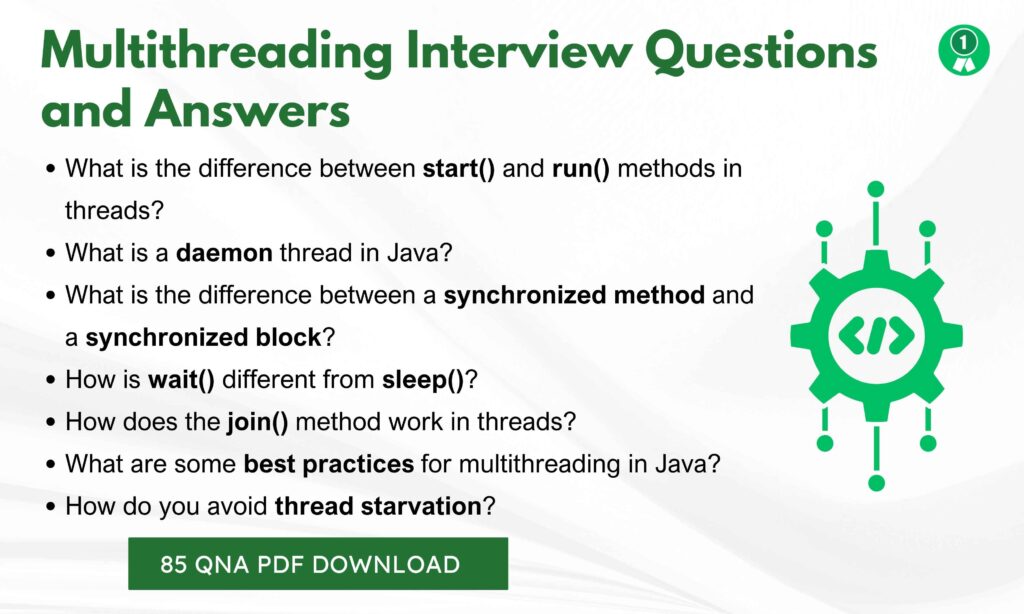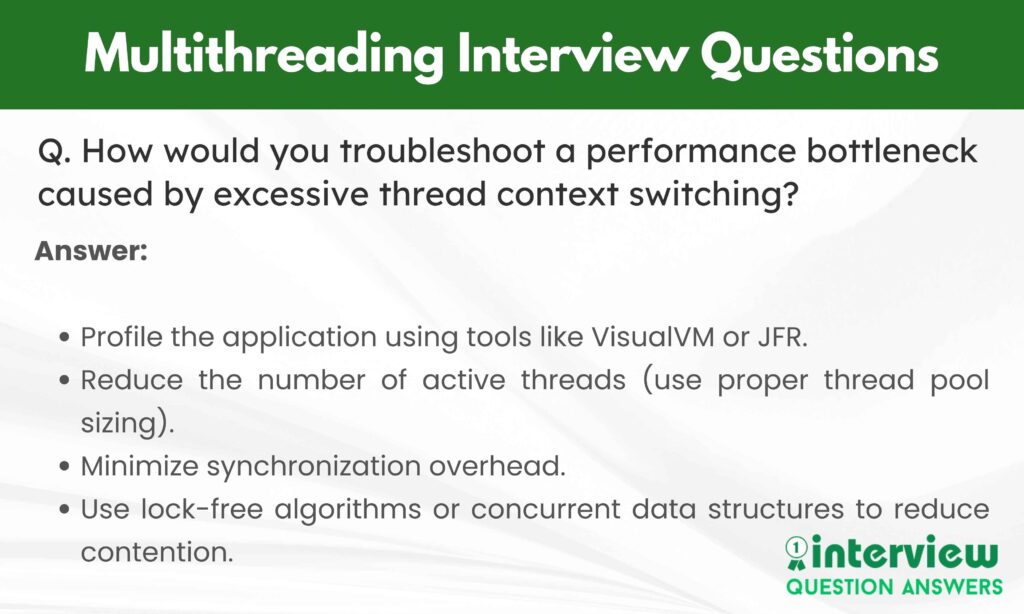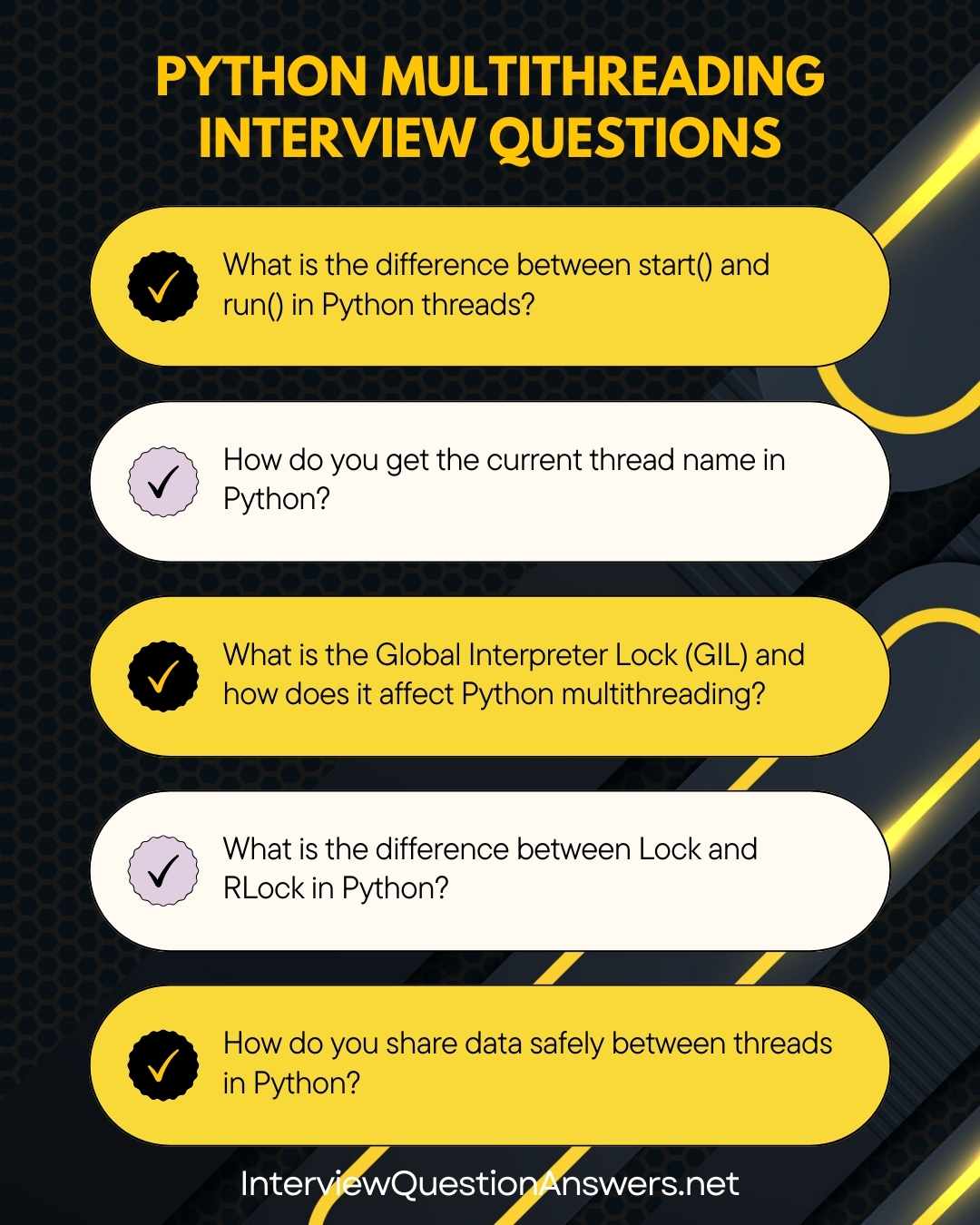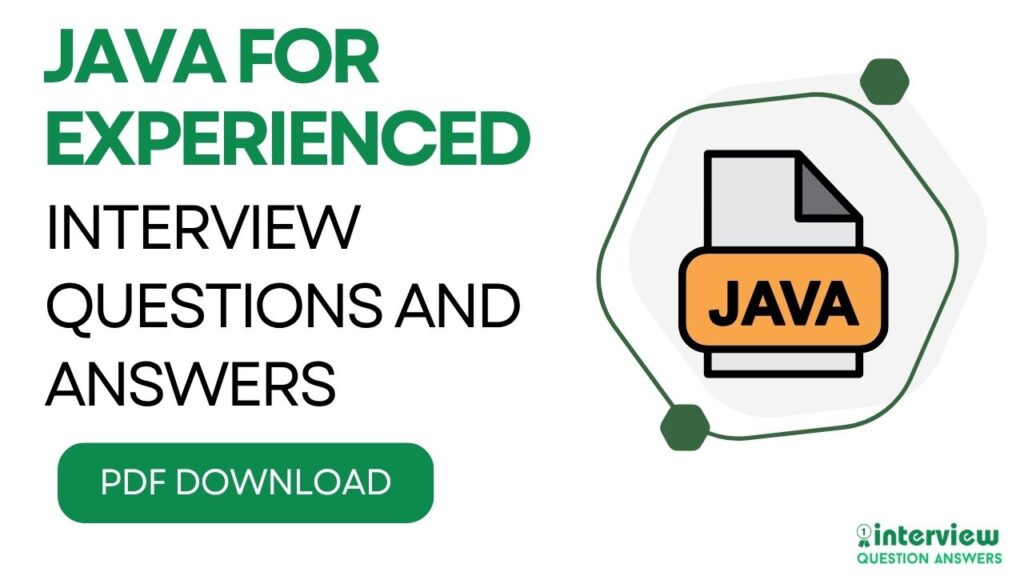Multithreading is a powerful programming concept that allows multiple threads to run concurrently within a single process, enabling faster execution and better resource utilization. A developer skilled in multithreading can optimize code to handle parallel tasks efficiently, avoid race conditions, and improve overall system throughput, making them highly valuable in today’s performance-driven software industry.
Multithreading is a must-have skill, especially for roles in Java, Python, and C++ development. Companies across domains are looking for professionals who can manage thread synchronization, deadlocks, concurrency issues, and parallel execution using language-specific tools and libraries.
This guide provides a curated list of Multithreading Interview Questions and Answers tailored for freshers, experienced candidates, and includes dedicated sections for Java, Python, and C++ multithreading.
Table of Contents
Multithreading Interview Questions and Answers for Freshers
Que 1. What is the difference between a thread and a process?
Answer:
A process is an independent unit of execution with its own memory, while a thread is a lightweight execution unit within a process that shares the process’s memory. Threads within the same process share resources, making communication easier but requiring synchronization for shared data.
Que 2. How can you create a thread in Java?
Answer:
There are two main ways:
- Extend the Thread class and override the run() method.
- Implement the Runnable interface and pass it to a Thread object.
Example:
class MyThread implements Runnable {
public void run() {
System.out.println("Thread is running...");
}
}
new Thread(new MyThread()).start();Que 3. What is the difference between start() and run() methods in threads?
Answer:
- start(): Creates a new thread and invokes the
run()method in that new thread. - run():Executes the code in the current thread if called directly, without starting a new thread.
Que 4. What are the different states of a thread?
Answer:
Threads can be in the following states:
- New
- Runnable
- Blocked
- Waiting
- Timed Waiting
- Terminated
Que 5. What is a daemon thread in Java?
Answer:
A daemon thread is a background thread that runs in the background to perform tasks like garbage collection. It ends automatically when all user threads have finished. You can set a thread as a daemon using thread.setDaemon(true) before starting it.
Que 6. What is thread priority and how does it affect thread execution?
Answer:
Thread priority determines the relative importance of threads. Higher-priority threads are given preference by the scheduler, but it doesn’t guarantee execution order. Priority is set using setPriority() method with values from 1 (MIN) to 10 (MAX).
Que 7. What is thread synchronization and why is it needed?
Answer:
Thread synchronization is the mechanism to control access of multiple threads to shared resources. It is needed to prevent race conditions and ensure data consistency when multiple threads modify shared data.
Que 8. What is the difference between a synchronized method and a synchronized block?
Answer:
- Synchronized method: Locks the entire method.
- Synchronized block: Locks only a specific section of code or object.
Synchronized blocks are generally preferred for better performance as they reduce lock contention.
Que 9. What is a race condition in multithreading?
Answer:
A race condition occurs when two or more threads access shared data simultaneously, and the final result depends on the timing of thread execution. Synchronization or thread-safe constructs are used to avoid race conditions.
Que 10. How does volatile keyword help in multithreading?
Answer:
The volatile keyword ensures that a variable’s value is always read from and written to the main memory, preventing threads from using cached values. It is useful for flags and simple state variables.
Que 11. How is wait() different from sleep()?
Answer:
- Wait(): Releases the lock on the object and waits until notify() or notifyAll() is called.
- sleep(): Pauses the thread for a specified time but does not release the lock.
Que 12. What are notify() or notifyAll() methods?
Answer:
- notify(): Wakes up one waiting thread.
- notifyAll(): Wakes up all waiting threads.
These methods are used in combination with wait() for inter-thread communication.
Que 13. What is the difference between Callable and Runnable?
Answer:
| Feature | Runnable | Callable |
|---|---|---|
| Return value | No (void) | Yes (returns a value) |
| Exceptions | Cannot throw checked exceptions | Can throw checked exceptions |
| Execution | Used with Thread | Used with ExecutorService |
Que 14. How does the join() method work in threads?
Answer:
The join() method allows one thread to wait until another thread finishes execution. Example:
Thread t = new Thread(() -> System.out.println("Task"));
t.start();
t.join(); // main thread waits for t to finishQue 15. What are thread pools and why are they used?
Answer:
A thread pool is a collection of reusable threads managed by an Executor. It improves performance by reducing the overhead of creating new threads for each task and allows better resource management.
Que 16. How does the Executor Framework help in multithreading?
Answer:
The Executor Framework provides a higher-level API for managing threads. It separates task submission from thread management and provides built-in thread pooling through classes like ThreadPoolExecutor and ScheduledExecutorService.
Que 17. What is deadlock and how can you prevent it?
Answer:
Deadlock occurs when two or more threads are waiting for each other’s resources indefinitely. Prevention strategies include:
- Acquiring locks in a fixed order.
- Using tryLock() with a timeout.
- Minimizing synchronized code blocks.
Que 18. What is a reentrant lock in Java?
Answer:
A reentrant lock (from java.util.concurrent.locks.ReentrantLock) allows a thread to acquire the same lock multiple times without causing deadlock. It provides more advanced features than the synchronized keyword, such as try-locking and fairness policies.
Que 19. How can you handle thread safety without using synchronized?
Answer:
- Use thread-safe classes like ConcurrentHashMap or CopyOnWriteArrayList.
- Use atomic variables (AtomicInteger, AtomicLong).
- Employ immutable objects.
Que 20. What are some best practices for multithreading in Java?
Answer:
- Keep synchronized sections as small as possible.
- Avoid nested locks.
- Use concurrent utilities instead of manual synchronization.
- Handle exceptions properly in threads.
- Test thoroughly as multithreading bugs are hard to reproduce.

Also Check: Full Stack Developer Interview Questions
Multithreading Interview Questions and Answers for Experienced
Que 21. What is the difference between user threads and daemon threads?
Answer:
User threads perform the main tasks of the application and keep the JVM alive until they finish execution. Daemon threads are background threads (like garbage collection) and the JVM terminates when all user threads finish, regardless of daemon threads running.
Que 22. How do you avoid thread starvation?
Answer:
Thread starvation happens when low-priority threads are perpetually waiting because high-priority threads monopolize CPU. To avoid it:
- Use fair locks (e.g., new ReentrantLock(true)).
- Avoid overly relying on thread priorities.
- Use modern executors with fairness policies.
Que 23. How does ThreadLocal work and when would you use it?
Answer:
ThreadLocal provides thread-confined variables, where each thread has its own independent copy.
Use cases:
- Storing user session data in multi-threaded environments.
- Maintaining database connection or transaction context per thread.
Que 24. What is the difference between synchronized and ReentrantLock ?
Answer:
| Feature | synchronized | ReentrantLock |
|---|---|---|
| Lock fairness | No | Can be fair (FIFO) |
| Try for lock | No | Yes (tryLock()) |
| Interruptible | No | Yes |
| Condition variables | No | Yes (supports multiple) |
Que 25. What is a ReadWriteLock and when is it beneficial?
Answer:
ReadWriteLock allows multiple readers or a single writer at the same time. It improves concurrency when reads are more frequent than writes.
Example:
ReadWriteLock lock = new ReentrantReadWriteLock();
lock.readLock().lock();
// perform read
lock.readLock().unlock();Que 26. How does the Java memory model impact multithreading?
Answer:
The Java Memory Model defines how threads interact through memory, ensuring happens-before relationships. It specifies visibility guarantees of variables (e.g., volatile ensures writes are visible to all threads) and ordering of operations to avoid race conditions.
Que 27. What are the differences between submit() and execute() in ExecutorService?
Answer:
- execute(): Executes a Runnable task and does not return a value.
- submit(): Executes a Runnable or Callable task and returns a Future object for tracking completion and result retrieval.
Que 28. How do you detect and resolve deadlocks in a running application?
Answer:
Detection methods:
- Using tools like jconsole, jstack, or profilers to find threads in WAITING state.
Resolution:
- Acquire locks in a fixed order.
- Use timeouts with tryLock().
- Break circular dependencies in code design.
Que 29. What is the difference between notify() and notifyAll() and when would you prefer one over the other?
Answer:
- notify() wakes up one waiting thread, while notifyAll() wakes all waiting threads.
Use notify() if only one thread can proceed. Use notifyAll() when multiple waiting threads might proceed, especially in complex conditions to avoid deadlocks.
Que 30. How does ForkJoinPool work in Java?
Answer:
ForkJoinPool is designed for tasks that can be split (forked) into subtasks and combined (joined) for results. It uses a work-stealing algorithm, where idle threads “steal” tasks from busy threads’ queues, maximizing CPU utilization.
Que 31. What is the difference between ConcurrentHashMap and Collections.synchronizedMap() ?
Answer:
- ConcurrentHashMap: Allows concurrent read and write operations with fine-grained locking on buckets.
- synchronizedMap(): Locks the entire map for every operation, leading to reduced concurrency.
Que 32. What is the purpose of the CountDownLatch class?
Answer:
CountDownLatch allows one or more threads to wait until a set of operations in other threads complete. Example:
CountDownLatch latch = new CountDownLatch(3);
latch.await(); // waits until count reaches 0Que 33. How is CyclicBarrier different from CountDownLatch ?
Answer:
- CountDownLatch: One-time use; threads wait for a count to reach zero.
- CyclicBarrier: Can be reused; a fixed number of threads wait for each other to reach a common barrier point before proceeding.
Que 34. How do you handle exceptions in ExecutorService tasks?
Answer:
- Use Future.get() which wraps exceptions in ExecutionException.
- Implement a custom ThreadPoolExecutor.afterExecute() method for centralized exception handling.
- Use setUncaughtExceptionHandler() for uncaught exceptions in threads.
Que 35. What are atomic classes and why are they important in concurrency?
Answer:
Atomic classes like AtomicInteger provide thread-safe operations using low-level Compare-And-Swap (CAS). They allow lock-free, efficient updates without explicit synchronization.
Que 36. How would you prevent false sharing in multithreaded applications?
Answer:
False sharing occurs when threads modify variables close in memory, causing cache line invalidations.
Solutions:
- Padding variables with unused fields (@Contended).
- Grouping related variables together and isolating unrelated ones.
Que 37. What is the difference between fair and non-fair locks?
Answer:
- Fair locks grant access in the order threads requested it (FIFO).
- Non-fair locks allow threads to “barge in” for faster throughput, but may cause starvation.
Example: new ReentrantLock(true) creates a fair lock.
Que 38. How do you implement thread-safe lazy initialization?
Answer:
Use the Double-Checked Locking pattern with volatile:
private volatile static Singleton instance;
public static Singleton getInstance() {
if(instance == null) {
synchronized(Singleton.class) {
if(instance == null) {
instance = new Singleton();
}
}
}
return instance;
}Que 39. How does the CompletableFuture API simplify asynchronous programming?
Answer:
CompletableFuture allows chaining tasks (thenApply, thenCombine), combining multiple futures, handling exceptions (exceptionally), and using non-blocking callbacks, making asynchronous programming more readable and manageable.
Que 40. How would you troubleshoot a performance bottleneck caused by excessive thread context switching?
Answer:
- Profile the application using tools like VisualVM or JFR.
- Reduce the number of active threads (use proper thread pool sizing).
- Minimize synchronization overhead.
- Use lock-free algorithms or concurrent data structures to reduce contention.

Also Check: OOPs Interview Questions and Answers
Java Multithreading Interview Questions and Answers
Que 41. How can you create a thread in Java?
Answer:
There are two main approaches:
- Extend the Thread class and override run().
- Implement the Runnable interface and pass it to a Thread object.
Example:
class MyTask implements Runnable {
public void run() {
System.out.println("Task running...");
}
}
new Thread(new MyTask()).start();Que 42. What is the difference between start() and run() in threads?
Answer:
- start(): Creates a new thread and calls the run() method inside it.
- run(): Executes the code in the current thread if called directly, not creating a new thread.
Que 43. What are thread states in Java?
Answer:
A thread can be in one of these states: New, Runnable, Blocked, Waiting, Timed Waiting, or Terminated. Transitions occur based on method calls like start(), sleep(), or join() .
Que 44. What is the difference between user threads and daemon threads?
Answer:
User threads keep the JVM alive until they finish. Daemon threads run in the background (e.g., garbage collector) and terminate automatically when all user threads end.
Que 45. What is thread synchronization and why is it needed?
Answer:
Thread synchronization controls concurrent access to shared resources to prevent race conditions and data inconsistency. This is done using synchronized blocks, locks, or concurrent collections.
Que 46. How is a synchronized block different from a synchronized method?
Answer:
- Synchronized method: Locks the entire method.
- Synchronized block: Locks only a specific block of code, offering finer control and better performance.
Que 47. How does volatile differ from synchronized?
Answer:
- volatile: Ensures visibility of variable updates across threads but does not guarantee atomicity.
- synchronized: Ensures both visibility and atomicity by locking.
Que 48. What is the difference between wait() and sleep()?
Answer:
- wait(): Releases the lock and waits until notify()/notifyAll() is called.
- sleep(): Pauses thread execution for a specified time but does not release the lock.
Que 49. What are notify() and notifyAll() used for?
Answer:
They are used for inter-thread communication.
- notify(): Wakes up one waiting thread.
- notifyAll(): Wakes up all waiting threads on the object’s monitor.
Que 50. How do Callable and Runnable differ?
Answer:
| Feature | Runnable | Callable |
|---|---|---|
| Return value | void | Returns a value |
| Exceptions | Cannot throw checked exceptions | Can throw checked exceptions |
| Execution | Passed to Thread | Submitted to ExecutorService |
Que 51. What is ExecutorService and why is it preferred over creating threads manually?
Answer:
ExecutorService manages a pool of threads, reuses them for tasks, and handles queueing, scheduling, and shutdown automatically. It improves performance and resource management compared to creating new threads for every task.
Que 52. How do you prevent deadlocks in multithreaded applications?
Answer:
- Acquire locks in a consistent order.
- Use timeouts with tryLock().
- Minimize synchronized sections.
- Use high-level concurrency utilities (e.g., java.util.concurrent).
Que 53. What is ThreadLocal and when would you use it?
Answer:
ThreadLocal provides thread-confined variables, meaning each thread has its own value. It’s useful for storing user sessions or transactional data in a multi-threaded environment.
Que 54. What is the difference between CountDownLatch and CyclicBarrier ?
Answer:
- CountDownLatch: One-time use; threads wait for a count to reach zero.
- CyclicBarrier: Can be reused; threads wait at the barrier until all reach it, then continue together.
Que 55. What is ForkJoinPool and how does it work?
Answer:ForkJoinPool is designed for tasks that can be recursively split into smaller tasks using the fork-join framework. It uses a work-stealing algorithm, where idle threads steal tasks from others’ queues to maximize throughput.
Que 56. What is the difference between a Thread and a Runnable in Java?
Answer:Thread is a class in Java that represents a thread of execution, while Runnable is an interface with a single run() method that defines the task to be executed by a thread. Runnable is preferred for task definition as it allows better flexibility, such as reusing the task across multiple threads or extending another class.
class MyTask implements Runnable {
public void run() {
System.out.println("Task running");
}
}
Thread thread = new Thread(new MyTask());
thread.start();Que 57. How do you achieve thread synchronization in Java using the synchronized keyword?
Answer:
The synchronized keyword ensures that only one thread can access a method or block at a time, preventing race conditions. It can be applied to methods or blocks, locking on an object or class.
class Counter {
private int count = 0;
public synchronized void increment() {
count++;
}
}Use synchronized blocks for finer control to minimize the locked scope.
Que 58. What is the purpose of the volatile keyword in Java multithreading?
Answer:
The volatile keyword ensures a variable’s value is always read from and written to main memory, preventing thread-local caching. It guarantees visibility of changes across threads but does not provide atomicity.
class Shared {
volatile boolean flag = false;
}Use for simple flags or state variables in concurrent applications.
Que 59. How does the ExecutorService framework simplify thread management in Java?
Answer:ExecutorService manages a pool of threads, abstracting thread creation and lifecycle. It provides methods like submit() for tasks and supports thread pooling, shutdown, and task scheduling, improving scalability.
ExecutorService executor = Executors.newFixedThreadPool(2);
executor.submit(() -> System.out.println("Task executed"));
executor.shutdown();Que 60. What is a deadlock in Java, and how can you prevent it?
Answer:
A deadlock occurs when two or more threads wait indefinitely for each other to release resources. Prevent it by enforcing a consistent lock acquisition order, using timeouts with tryLock(), or avoiding nested locks.
// Example avoiding deadlock with ordered locking
Object lock1 = new Object(), lock2 = new Object();
Thread t1 = new Thread(() -> {
synchronized(lock1) {
synchronized(lock2) {
// Critical section
}
}
});Analyze with tools like JVisualVM to detect deadlocks.
Also Check: Java interview Questions and Answers
Python Multithreading Interview Questions and Answers
Que 61. How can you create a thread in Python?
Answer:
You can create a thread using the threading module:
import threading
def task():
print("Thread running")
t = threading.Thread(target=task)
t.start()Alternatively, you can subclass Thread and override the run() method.
Que 62. What is the difference between start() and run() in Python threads?
Answer:
- start(): Starts a new thread and calls the run() method in that thread.
- run(): Executes in the current thread if called directly, without starting a new thread.
Que 63. What are daemon threads in Python?
Answer:
Daemon threads run in the background and are terminated when all non-daemon threads finish. You can set a thread as daemon using:
t.daemon = True
t.start()Que 64. How do you get the current thread name in Python?
Answer:
Use threading.current_thread().name:
import threading
print(threading.current_thread().name)Que 65. What are the different states of a Python thread?
Answer:
Threads can be in the following states:
- New (created but not started)
- Runnable (ready to run)
- Running (executing code)
- Waiting (waiting for a resource or event)
- Terminated (finished execution)
Que 66. What is the Global Interpreter Lock (GIL) and how does it affect Python multithreading?
Answer:
The GIL is a mutex that prevents multiple native threads from executing Python bytecodes simultaneously. It ensures thread safety but limits true parallel execution in CPU-bound tasks. For CPU-bound work, multiprocessing is often a better choice.
Que 67. How can you synchronize threads in Python?
Answer:
You can use the Lock class:
import threading
lock = threading.Lock()
with lock:
# critical sectionThis ensures only one thread accesses the critical section at a time.
Que 68. What is the difference between Lock and RLock in Python?
Answer:
- Lock: Cannot be acquired multiple times by the same thread without deadlocking.
- RLock (Reentrant Lock): Allows the same thread to acquire it multiple times safely.
Que 69. How does join() work in Python threads?
Answer:
join() blocks the calling thread until the target thread finishes:
t = threading.Thread(target=task)
t.start()
t.join() # waits until t is doneQue 70. How do you share data safely between threads in Python?
Answer:
- Use synchronization primitives like Locks.
- Use thread-safe queues (queue.Queue) for producer-consumer scenarios.
- Use ThreadLocal storage for thread-specific data.
Que 71. What is the difference between Thread and ThreadPoolExecutor ?
Answer:
| Feature | Thread | ThreadPoolExecutor |
|---|---|---|
| Creation | Manual for each task | Uses a pool of reusable threads |
| Task submission | start() | submit() or map() |
| Scalability | Less | More (manages threads internally) |
Que 72. How do you use ThreadPoolExecutor in Python?
Answer:
from concurrent.futures import ThreadPoolExecutor
def task(n):
print(f"Task {n} running")
with ThreadPoolExecutor(max_workers=3) as executor:
for i in range(5):
executor.submit(task, i)Que 73. What is a condition variable in Python threading?
Answer:
A condition variable allows threads to wait for certain conditions to be met.
cond = threading.Condition()
with cond:
cond.wait() # wait for notification
cond.notify() # notify waiting threadsQue 74. How can you avoid race conditions in Python multithreading?
Answer:
- Use Locks or RLocks to protect shared data.
- Use thread-safe data structures (Queue, deque).
- Minimize shared state between threads.
Que 75. How would you debug a deadlock issue in Python multithreading?
Answer:
- Use threading.enumerate() to list all active threads.
- Check locks that are acquired but never released.
- Use faulthandler module or logging to trace where threads are stuck.
- Design code to avoid circular dependencies when acquiring multiple locks.
Que 76. What is the Global Interpreter Lock (GIL) in Python, and how does it affect multithreading?
Answer:
The GIL is a mutex that protects access to Python objects, preventing multiple native threads from executing Python bytecodes simultaneously in CPython. It limits true parallelism in CPU-bound tasks, as only one thread executes Python code at a time, making multithreading more suitable for I/O-bound tasks.
import threading
def task():
for _ in range(1000000):
pass
threads = [threading.Thread(target=task) for _ in range(4)]
for t in threads:
t.start()
for t in threads:
t.join()Use multiprocessing for CPU-bound tasks to bypass GIL.
Que 77. How do you create and start a thread in Python?
Answer:
Use the threading module to create a thread by subclassing Thread or passing a target function to Thread. Start it with the start() method.
import threading
def print_numbers():
for i in range(5):
print(i)
thread = threading.Thread(target=print_numbers)
thread.start()
thread.join()Que 78. How do you synchronize threads in Python to avoid race conditions?
Answer:
Use threading.Lock to ensure only one thread accesses shared resources at a time. Acquire the lock before critical sections and release it afterward.
import threading
lock = threading.Lock()
counter = 0
def increment():
global counter
with lock:
counter += 1
threads = [threading.Thread(target=increment) for _ in range(10)]
for t in threads:
t.start()
for t in threads:
t.join()Que 79. What is the difference between threading.Event and threading.Semaphore in Python?
Answer:threading.Event is used for signaling between threads, allowing one thread to wait until another sets the event. threading.Semaphore controls access to a resource pool by limiting the number of threads that can access it simultaneously.
import threading
event = threading.Event()
def wait_for_signal():
event.wait()
print("Event received")
threading.Thread(target=wait_for_signal).start()
event.set()Que 80. How do you handle thread termination gracefully in Python?
Answer:
Use a flag or threading.Event to signal threads to stop, combined with join() to ensure clean termination. Avoid abrupt termination to prevent resource leaks.
import threading
stop_event = threading.Event()
def task():
while not stop_event.is_set():
print("Running")
stop_event.wait(1)
thread = threading.Thread(target=task)
thread.start()
stop_event.set()
thread.join()
Also Check: Python Interview Questions and Answers
C++ Multithreading Interview Questions and Answers
Que 81. How can you create a thread in C++?
Answer:
You can create a thread using the std::thread class from the <thread> library:
#include <iostream>
#include <thread>
void task() {
std::cout << "Thread running\n";
}
int main() {
std::thread t(task);
t.join(); // wait for thread to finish
}Que 82. What is the difference between join() and detach() in C++ threads?
Answer:
- join(): Blocks the calling thread until the thread finishes execution.
- detach(): Separates the thread from the thread object, allowing it to run independently (as a daemon thread).
Que 83. What are the different states a C++ thread can be in?
Answer:
Threads can be:
- Joinable: Started and can be joined.
- Not joinable: Finished, detached, or never started.
Que 84. How do you pass arguments to a thread function?
Answer:
void task(int x) { std::cout << x; }
std::thread t(task, 5);
t.join();Use std::ref if you need to pass arguments by reference.
Que 85. What is a race condition and how can it be avoided in C++?
Answer:
A race condition occurs when multiple threads access shared data simultaneously without synchronization. It can be avoided by using mutexes, locks, or atomic operations.
Que 86. What is the difference between std::mutex and std::recursive_mutex ?
Answer:
- std::mutex: Cannot be locked multiple times by the same thread.
- std::recursive_mutex: Allows the same thread to acquire the lock multiple times, but must release it the same number of times.
Que 87. How does std::lock_guard simplify mutex management?
Answer:
std::lock_guard automatically acquires the lock when created and releases it when it goes out of scope, preventing deadlocks caused by forgetting to unlock.
std::mutex m;
void safe() {
std::lock_guard<std::mutex> guard(m);
// critical section
}Que 88. What is the difference between std::unique_lock and std::lock_guard ?
Answer:
| Feature | std::lock_guard | std::unique_lock |
|---|---|---|
| Flexibility | Less (RAII only) | More (can lock/unlock multiple times) |
| Deferred locking | No | Yes |
| Condition variable | Cannot use | Can use with wait () |
Que 89. How do you use condition variables in C++ multithreading?
Answer:
std::mutex m;
std::condition_variable cv;
bool ready = false;
void worker() {
std::unique_lock<std::mutex> lock(m);
cv.wait(lock, [] { return ready; });
// work
}cv.notify_one() or cv.notify_all() wakes up waiting threads.
Que 90. What is a deadlock and how can it be avoided?
Answer:
A deadlock occurs when threads wait indefinitely for locks held by each other. Avoid it by:
- Locking resources in a consistent order.
- Using std::lock() to acquire multiple locks atomically.
- Using try-lock techniques.
Que 91. What is std::future and how does it work with threads?
Answer:
std::future holds the result of an asynchronous operation. You can use it with std::async or std::promise to retrieve return values from threads:
auto f = std::async([] { return 42; });
std::cout << f.get();Que 92. What is the difference between std::async and std::thread ?
Answer:
- std::thread: Starts a thread immediately and does not manage return values.
- std::async: Starts tasks lazily or eagerly and provides a std::future to access results and exceptions.
Que 93. How does std::atomic help in multithreading?
Answer:
std::atomic provides operations on variables that are atomic, meaning they can’t be interrupted. It helps avoid race conditions without using mutexes.
std::atomic<int> counter(0);
counter++;Que 94. What is a thread-safe singleton and how can you implement it in C++?
Answer:
Use std::call_once and std::once_flag for thread-safe initialization:
class Singleton {
static Singleton* instance;
static std::once_flag flag;
Singleton() {}
public:
static Singleton* getInstance() {
std::call_once(flag, [] { instance = new Singleton(); });
return instance;
}
};Que 95. How would you detect and debug deadlocks in a C++ multithreaded application?
Answer:
- Use logging to track lock acquisition order.
- Use tools like Valgrind, ThreadSanitizer, or gdb for deadlock detection.
- Enforce consistent lock order and use timeout-based lock acquisition (try_lock_for).
Que 96. What is the purpose of std::thread in C++ multithreading?
Answer:std::thread (introduced in C++11) creates and manages a new thread of execution. It allows running a function or callable object concurrently, improving performance for parallel tasks.
#include <thread>
void task() { std::cout << "Thread running\n"; }
std::thread t(task);
t.join();Que 97. How do you synchronize threads in C++ to prevent race conditions?
Answer:
Use std::mutex to lock shared resources, ensuring only one thread accesses them at a time. std::lock_guard or std::unique_lock simplifies locking.
#include <mutex>
std::mutex mtx;
int counter = 0;
void increment() {
std::lock_guard<std::mutex> lock(mtx);
++counter;
}Que 98. What is the difference between std::mutex and std::atomic in C++?
Answer:std::mutex provides mutual exclusion for critical sections, while std::atomic ensures atomic operations on variables without locks, ideal for simple data types. std::atomic is faster for single variables but less flexible.
#include <atomic>
std::atomic<int> counter(0);
void increment() {
counter++;
}Que 99. How do you use std::condition_variable for thread coordination in C++?
Answer:std::condition_variable enables threads to wait for conditions or signals. Use with a mutex to avoid race conditions, calling wait() or notify_one()/notify_all().
#include <condition_variable>
std::mutex mtx;
std::condition_variable cv;
bool ready = false;
void wait_task() {
std::unique_lock<std::mutex> lock(mtx);
cv.wait(lock, [] { return ready; });
}
void signal() {
{
std::lock_guard<std::mutex> lock(mtx);
ready = true;
}
cv.notify_one();
}Que 100. What is a deadlock in C++ multithreading, and how can you prevent it?
Answer:
A deadlock occurs when threads wait indefinitely for each other’s resources. Prevent it by enforcing a consistent lock order, using std::lock for multiple mutexes, or employing timeouts with try_lock().
#include <mutex>
std::mutex mtx1, mtx2;
void task() {
std::lock(mtx1, mtx2);
std::lock_guard<std::mutex> lock1(mtx1, std::adopt_lock);
std::lock_guard<std::mutex> lock2(mtx2, std::adopt_lock);
// Critical section
}Multithreading Interview Questions PDF
You can also download our complete PDF guide that includes all questions and answers, perfect for studying offline anytime and anywhere.
FAQs: Multithreading Interview Questions
What does a professional working with multithreading typically do?
A professional specializing in multithreading is responsible for designing, implementing, and optimizing applications that can execute multiple tasks concurrently. Their role often involves handling synchronization, performance tuning, debugging complex concurrency issues, and ensuring thread-safe code in software projects.
What challenges might you face when working with multithreading?
Common challenges include dealing with race conditions, deadlocks, thread starvation, and performance bottlenecks caused by excessive context switching. Debugging multithreaded code is often harder because issues are non-deterministic and may only occur under certain conditions.
What difficulties are common during a multithreading interview?
Candidates often struggle with scenario-based questions about synchronization, thread-safe design, and performance optimization. Another challenge is demonstrating a deep understanding of concurrency mechanisms across programming languages and frameworks.
How much salary can a multithreading-focused developer expect in the USA?
In the USA, a developer with strong multithreading skills can expect an annual salary ranging from $100,000 to $150,000, depending on experience, industry, and location. Senior engineers or specialists in high-performance computing can earn even higher salaries.
Which top companies hire professionals with multithreading expertise?
Companies like Google, Amazon, Microsoft, Meta, Oracle, Bloomberg, Nvidia, and Intel often look for developers with strong multithreading and concurrency skills, especially for roles involving backend systems, real-time processing, and high-performance applications.
Are certifications or additional courses important for multithreading professionals?
While certifications are not always mandatory, advanced training in concurrent programming, system design, or performance engineering can add value. Courses in languages like Java, C++, Python, or frameworks supporting parallel computing are beneficial.
What career growth opportunities are available for developers skilled in multithreading?
Developers with strong multithreading skills can advance to roles such as Software Architect, Performance Engineer, System Design Lead, or Technical Manager. These skills are especially valued in industries like finance, gaming, distributed systems, and high-performance computing.
Conclusion
This multithreading interview guide helps you prepare for programming job interviews with questions for both new and experienced developers. The guide covers everything from basic concepts to advanced multithreading scenarios. Use this guide to practice and master multithreading concepts for your next interview.







